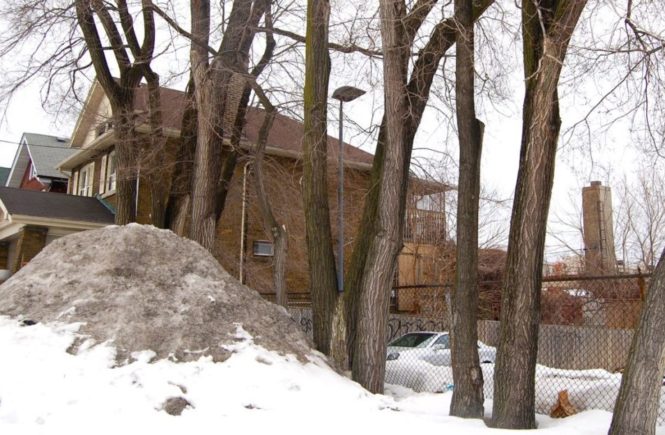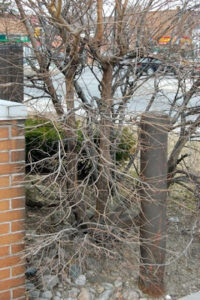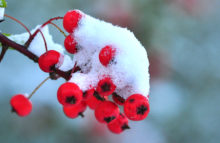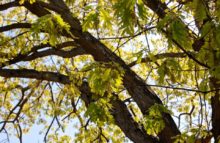 While we’re (almost) on the subject of overgrown trees, take a look at this little linear forest (shown in two seasons).
While we’re (almost) on the subject of overgrown trees, take a look at this little linear forest (shown in two seasons).
This was once a hedge. That is, it was a hedge till someone put away their shears. If you pay attention to the city’s garden archeology, you can spot these runaway hedges all over.
These now soaring giants are the non-native Siberian elm (Ulmus pumila). You can still see them in hedge form in every corner of Toronto. In full sun, they make a fast growing, fairly dense hedge when pruned regularly. (In shade, the hedge tends to be open and leggy.)
As a hedge, Siberian elm responds well to radical rejuvenation, if the trunks aren’t much beyond three to four inches in diameter. That means, if you find yourself with a fifteen foot Siberian elm hedge too tall to trim, you can actually lop it off to a horrifying degree — as much as a few inches from ground level. The stumps will send up new shoots, which you can then maintain at a more reasonable height. Be prepared to trim it at least twice a season.
If it’s useful as a hedge, why warn you? In a word: seeds.
This is a prolific seeder. It makes the typical elm seed, a winged samara, which is round with a raised centre and a papery skirt, sort of like a tiny flying saucer.
And fly it does. Siberian elms distribute themselves liberally, usually turning into a fast-growing interloper exactly where one would be least welcome. Crowding out your lovely Easte
rn redbud (Cercis canadensis), for instance.
In the picture on the right he
re, you can see a volunteer elm to the left and behind the silvery trunks of the serviceberry (Amelanchier) that was meant to take the stage at the corner of our local library. On the left, note how the attempt to trim the volunteer is making it thick and twiggy. (Of course, that’s what makes it a good hedge, too.)
At t
he top of the tree (pictured below) are tall branches beyond the reach of the hedge trimmer. If the whole tree is not nipped in its infancy now, this vigorous interloper will soon overwhelm the original tree.
As an
ornamental, there are far better choices.
Michael Dirr, whose book the Manual of Woody Landscape Plants is considered the bible on trees, shrubs and other woody plant materials, writes that it is: “one of, if not the, world’s worst trees…a poor ornam
online pharmacy buy wellbutrin with best prices today in the USAental that does not deserve to be planted anywhere!”
Exclamation mark is his.
Don’t mistake it for the native American elm (Ulmus americana), the graceful, vase-shaped tree that was almost eradicated by Dutch elm disease.
 If you have a Siberian elm hedge – or runaway hedge – nearby, keep an eye out for the volunteer trees and nip them in the bud before they become a pest. In the first year or two of their lives, you can recognize Siberian elm saplings by their slightly zig-zag what I think of as fishbone growth habit in their second year.
If you have a Siberian elm hedge – or runaway hedge – nearby, keep an eye out for the volunteer trees and nip them in the bud before they become a pest. In the first year or two of their lives, you can recognize Siberian elm saplings by their slightly zig-zag what I think of as fishbone growth habit in their second year.
Know what you grow. While we do want more trees in the city, a forest of aggressive aliens makes things tough for our native flora. Besides, this one makes lots of work for our hardworking gardeners
. Please be a good garden citizen, and check your elm hedge at the door.







5 comments
I think I know that elm “hedge” in the top photo! It’s next to Coxwell subway station, right?
That’s the one. Sharp eyes.
thanks for pointing out the “hedge” history of siberian elms. I would’ve mistaken it as an old fence line where invasive tree seeds blew in (like tree-of-heaven often does.)
Thank you, thank you for the qoute by Dirr, we were about to buy these horrible trees!
That explains why we have so many horrible 30-ft Siberian elms crowded along the back of our yard – it was supposed to be a hedge! The previous owner must not have known. We are having them removed this fall. The seeds are way too much to handle.